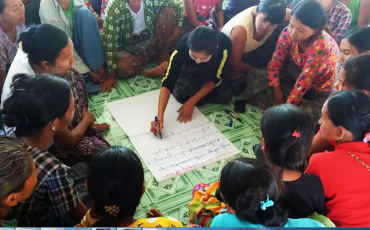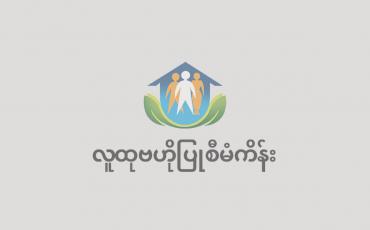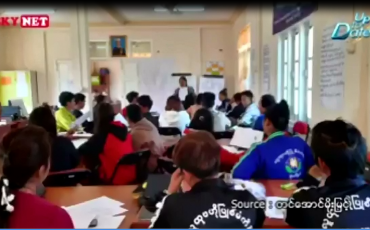1. On 26 August 2016, IFI Watch Myanmar released a report on the Myanmar National Community Driven Development Project (NCDDP). The Department of Rural Development (DRD), as the implementing agency for the NCDDP, welcomes this report and the continuing engagement by IFI Watch. However as IFI Watch Myanmar did not contact DRD to verify the claims made in the report, the following aims to clarify some of the key issues raised. DRD remains ready to respond to any of these or other issues in more detail, as part of its commitment to transparency and to regular engagement with civil society.
2. Insufficient community engagement (Pages 2, 3 & 16): To respond to the community’s commitment, key components of NCDDP are the communication of information, as well as transparent and active coordination of the project progress in the implementation area. The claims in the IFI Watch report are not consistent with the findings on the ground in the current cycle 3 (financial year 2015/2016), 62 percent of households across 27 townships are participating actively in community meetings, including the formation of committees and formulation of village development plans. Social audits conducted in all project villages at the end of the last community cycle show that 95% of the community were satisfied or very satisfied with project results and process.
3. Union Multi Stakeholder Reviews: these are conducted annually at the end of the cycle; in addition, DRD and World Bank conduct meetings with civil society at least 3 times a year. A summary of such meetings can be found on the project website.
4. In the first cycle of project implementation, DRD project offices can be early opened within November in relevant township. The contracting of project implementation township technical advisor groups has to be done in accordance with the procurement process of World Bank. After contracting these groups, there may be delays in the hiring of local community facilitators. Community engagement has subsequently started earlier in most participating communities; in the project implementation; the community can be supported for capacity building over 4 cycles.
5. Before project implementation, DRD introduced a socialization workshop in the township attended by civil society organization in the region and ethnic organizations and stakeholders. The project visibility materials such as caps, T-shirt, pens, posters and pamphlets using logo were distributed at the very beginning of the Implementation by the project field staffs facilitators to community committee members. In addition, the project movie “Our Village and Our Project” as an dissemination of the project mechanism by broadcasting at the TV channels as many as possible.
6. Insufficient technical quality: The IFI report concerns the technical quality for implementation. Since its inception in 2013, the NCDDP has delivered a total Block grants of 46.8 billion MMK to over 5,400 villages across 27 townships. These grants have financed the construction of rural infrastructures ranging from school expansions to water supplies to improved roads and foot paths. The implementation processes include preparation, designing, implementation, monitoring and etc., with the inclusion of rural communities. The third party technical audit reports that 92 percent of subprojects were considered “satisfactory” or “very satisfactory”.
7. Insufficient training for community facilitators: In page 4, 9, 12 and 14 of the IFI reports pointed out that the project does not conducted sufficient training for community facilitators. The project is
2
implementing over 1800 community facilitators from 27 townships, but the survey was not covering the majority or the whole project sites.
8. It is the milestone of NCDDP on continuous capacity building to community, community facilitators, and technical facilitators. The majority of community facilitators are hired locally in each township, providing job opportunities in remote areas for young people looking to support their communities, and providing critical local knowledge (including of local languages) for the project. This reliance on local community facilitators is the key character of the project to get her successful implementation.
9. The outcome of the 2015 union multi-stakeholder review meeting highlighted the gaps in the training program of NCDDP. The training arrangements within the first year project cycle were: (1) one-start up training of 7 days for DRD staff of project townships and key experts, (2) the three trainings, altogether 20 days, for facilitators, (3) the three infrastructure trainings, altogether 12 days, for technical facilitators, (4) the three trainings on trainer (TOT/iTOT) for community facilitators and technical facilitators, (5) a technical training on area, such as communication, gender, etc., and a time refresher course of training.
10. The NCDDP conducted trainings on project staff; 41 trainings at union level, 495 trainings at township level and 4536 trainings at community level. At the union level, the union NCDDP secretariat conducted start up training, refresher training, training of trainers (TOT), and infrastructure training for township level project staff. The township NCDDP secretariats conducted the Facilitator trainings in accordance with the project cycle. At the community level, the Facilitators conducted community level management training, procurement training, financial training and grievance training to the village committee members, volunteers and finance clerks of village at the village level.
11. The above trainings are designed and updated the training curriculum and materials at the township level to make more effective and meet the local context need. The trainings are planned as per need of the capacity requirement of the process and steps of the project. The updated training plan are also drawn and implemented based on the lessons learned in the existing township trainings, the continuous trainings are conducted to build capacity of staffs including facilitators.
12. Lack of transparency: Regarding lack of transparency (Page refs 11, 21, 23, 24), NCDDP implemented a Grievance Redress Mechanism (GRM) at the very beginning of the project 2013, a new bottom up feedback loop to ensure the project is implemented transparently and accountably. To date, the project’s GRM received 2,894 grievances from various stakeholders such as villagers, contractors, facilitators, project staff, authorities, and CSOs, including IFI Watch. By the end of June, 89 percent of issues raised through the GRM had been addressed. As this is a new approach, the project GRM has also been providing a continuous sensitization to the project staff, facilitators and communities to increase awareness and to improve the functionality of the system.
13. In the first year project cycle and the second year project cycle, the grievances were classified as follows: 297 general inquiries about project policies and procedures, 105 issues of violation the project policies, guidelines and procedure of the project, 27 misuse of fund, 34 issues of improper intervention, 33 other issues which are from the outside of the scope of project, 94 appreciations and 781 suggestions. In total 1351 issues were being solved and responded.
14. In the first year cycle Grievance team of NCDDP received 318 issues from three townships, 1348 issues from nine townships in the second year cycle of the project, all solved. At the third project cycle, 3361 issues from 27 townships, of these, 2282 grievances had been completely resolved, and 539 issues are currently in process of handling.
3
15. The grievance collection is not limited to feedback boxes placed in each village only (a box to be opened at least every two weeks by the village grievance focal point), other channels such as direct letters to the union and township DRD offices or technical assistance teams, dedicated email address for the project GRM, dedicated phone line, and the project website (cdd.drdmyanmar.org) and social media of NCDDP Myanmar Facebook public group. Several in-depth investigations have been conducted to follow up on allegations such as violations of project guidelines.
16. The specific allegations seem to be drawn from a previous reports by IFI Watch, which led to a DRD investigations. DRD responded on those reports on, 10-2-2015 and 9-3-2016. The detail response of DRD can be found at the project website cdd.drdmyanmar.org. All feedback received is properly documented, and uploaded to the project’s website. Grievances will be disclosed publicly, but anonymously unless the aggrieved person self-identifies him/herself.
4
Request to World Bank and DRD:
We want clear, understandable awareness on CDD.
The engineers should visit the project sites at the beginning of the implementation as we need technical advice. We want efficient engineers to explain technical issues and provide good advice”
We also want capacity building for the female communities.
Livelihood trainings (it was not included in English version report but in Myanmar version)
To move the complaint letter box from the public place [as we are afraid of others seeing]
We want TAs and CFs to monitor the project regularly
Responses and/or status:
All NCDDP township teams are disseminating clear messages and project mechanisms as soon as Technical Assistant teams on board.
Technical Facilitators (TF) are working at the community level implementation cooperating with and supervising community committees. The project hired a technical facilitator per 14 sub-projects. The TF are trained before starting the site works at the villages. Starting from project cycle 4, the state/regional CDD team will include two senior engineer officers and three technical consultants, who will supervise TFs of the townships.
The NCDDP gender team is expending the training modules and number of training by hiring a full-time Gender Specialist.
Livelihood training is not included in the project scope. But from FY 2017-18 to FY 2020-21, DRD planned 4926 livelihood training of agriculture, livestock, computer, mason and carpenter, electric wiring, cottage and etc.
The location of Grievance-box is decided at the village meeting, NCDDP union team is informing township teams to ensure to meet the villagers’ need who didn’t present at the meeting.
NCDDP township teams planned and visited the villages in the third project cycle and the township is separated into four or five small area and it is supervised by a TTA key expert.
ကျေးလက်ဒေသဖွံ့ဖြိုးတိုးတက်ရေးဦးစီးဌာန၏ မျှော်မှန်းချက် (Vision) မှာ စဉ်ဆက်မပြတ် ဖွံ့ဖြိုးမှုပန်းတိုင်နှင့်အညီ ကျေးလက်နေပြည်သူ များ၏ လူမှုစီးပွားဘဝဖွံ့ဖြိုးတိုးတက်လာစေရန် မျှော်မှန်းပါသည်။
ကျေးလက်ဒေသဖွံ့ဖြိုးတိုးတက်ရေးဦးစီးဌာန၏ ရည်မှန်းချက်များမှာ-
(၁) ကျေးလက်အခြေခံအဆောက်အအုံဖွံ့ဖြိုးရေးနှင့် ကျေးလက် အသက်မွေးဝမ်းကျောင်း ဖွံ့ဖြိုးတိုးတက်ရေးလုပ်ငန်းများ ဆောင်ရွက်ခြင်း ဖြင့် ကျေးလက်နေ ပြည်သူများ၏ လူမှုစီးပွားဘဝ မြင့်မားလာစေရန်... ဆက်လက်ဖတ်ရှုရန်

မြန်မာ နိုင်ငံ၏ ကျေးလက် ဒေသ ဖွံ့ဖြိုးရေးနှင့် ဆင်းရဲ နွမ်းပါးမှု လျော့ချရေး လုပ်ငန်းစဉ် များကို အထောက် အကူ ပြုစေရန် အတွက် ကမ္ဘာ့ဘဏ်မှ ကူညီ ထောက်ပံ့ငွေ အမေရိကန် ဒေါ်လာ (၈၀) သန်း နှင့် နည်းပညာ ပံ့ပိုး ကူညီမှု ဖြင့် မြန်မာ နိုင်ငံ၌ လူထု ဗဟိုပြု စီမံကိန်း (Community Driven Development - CDD) ကို စတင် အကောင်အထည်ဖော် ဆောင်ရွက်ခဲ့ ပါသည်။
ယခုအခါ စီမံကိန်း ဆောင်ရွက် အောင်မြင်မှု အပေါ် အားရ ကျေနပ်မှု ရှိသောကြောင့် ကမ္ဘာ့ဘဏ်မှ အမေရိကန်ဒေါ်လာ သန်း(၄၀ဝ) ကိုလည်းကောင်း၊ အီတလီအစိုးရမှ ယူရိုသန်း (၂၀) ကိုလည်းကောင်း အတိုးမဲ့ နှစ်ရှည် ချေးငွေအဖြစ် ရယူ၍ စီမံကိန်းကို တိုးချဲ့ဆောင်ရွက်လာခဲ့ပြီး နှစ်စဉ် နိုင်ငံတော် ဘတ်ဂျက်ထည့်ဝင်ငွေ အမေရိကန်ဒေါ်လာ (၅)သန်းဖြင့် (၆)နှစ်အတွက် သန်း(၃၀)ဖြင့် စုစုပေါင်းရန်ပုံငွေ အမေရိကန်ဒေါ်လာ (၅၃၂)သန်းဖြင့် အကောင်အထည်ဖေါ် ဆောင်ရွက်လျက် ရှိပါသည်။






